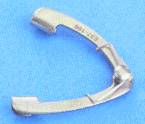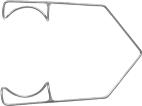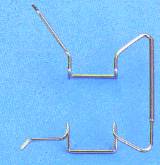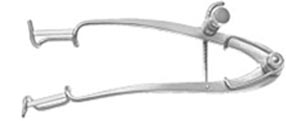Lid speculum
(An ideal speculum is one which can allow surgeon to
gain access to the eye with minimal pressure on the globe. Several designs
are available.)
|
|

Frankel paediatric speculum |

Sauer paediatric speculum |
These speculae are
designed for opening infant's eye during indirect
ophthalmoloscopy and cataract extraction. Frankel speculum
allows
adjustment of the width of the palpebral fissure. |
|
|

Barraquer wire speculum |
Speculum can be divided
into the rigid and the wire speculum. Barraquer is probably
the most widely used speculum for cataract extraction
especially during phacoemulsification
Its main disadvantage when compared with the rigid speculum
is that it cannot be used to adjust the width of the palpebral fissure. |
|

Pierce speculum |
Pierce speculum combine the features
of wire and rigid speculum. It allows adjustment of
the interpalpebral distance. |
|

Williams eye speculum |
This is a rigid speculum and allows
the width of the palpebral fissure to be adjusted. It is used
commonlyin strabismus or enucleation surgery where a
wide palpebral fissure is desirable. However, one main disadvantage of
a widely open eye is that the lateral canthus may push on the eye leading
to an increase in the intraocular pressure. Therefore, excessive widening
of the palpebral fissure should be avoided in patients with penetrating
injury. |
|

Lang speculum |
Lang speculum is a rigid speculum.
In addition, it has guards which help to keep the
eyelashes out of the operative fields. However, this
function has now been superseded
by the wide spread use of plastic drape which is excellent
in keeping the lashes out of
the way. One disadvantage of Lang's speculum is that
it can slip out of the eyes if the lids
are floppy as during evisceration or enucleation of a
pthisical eye. |
|